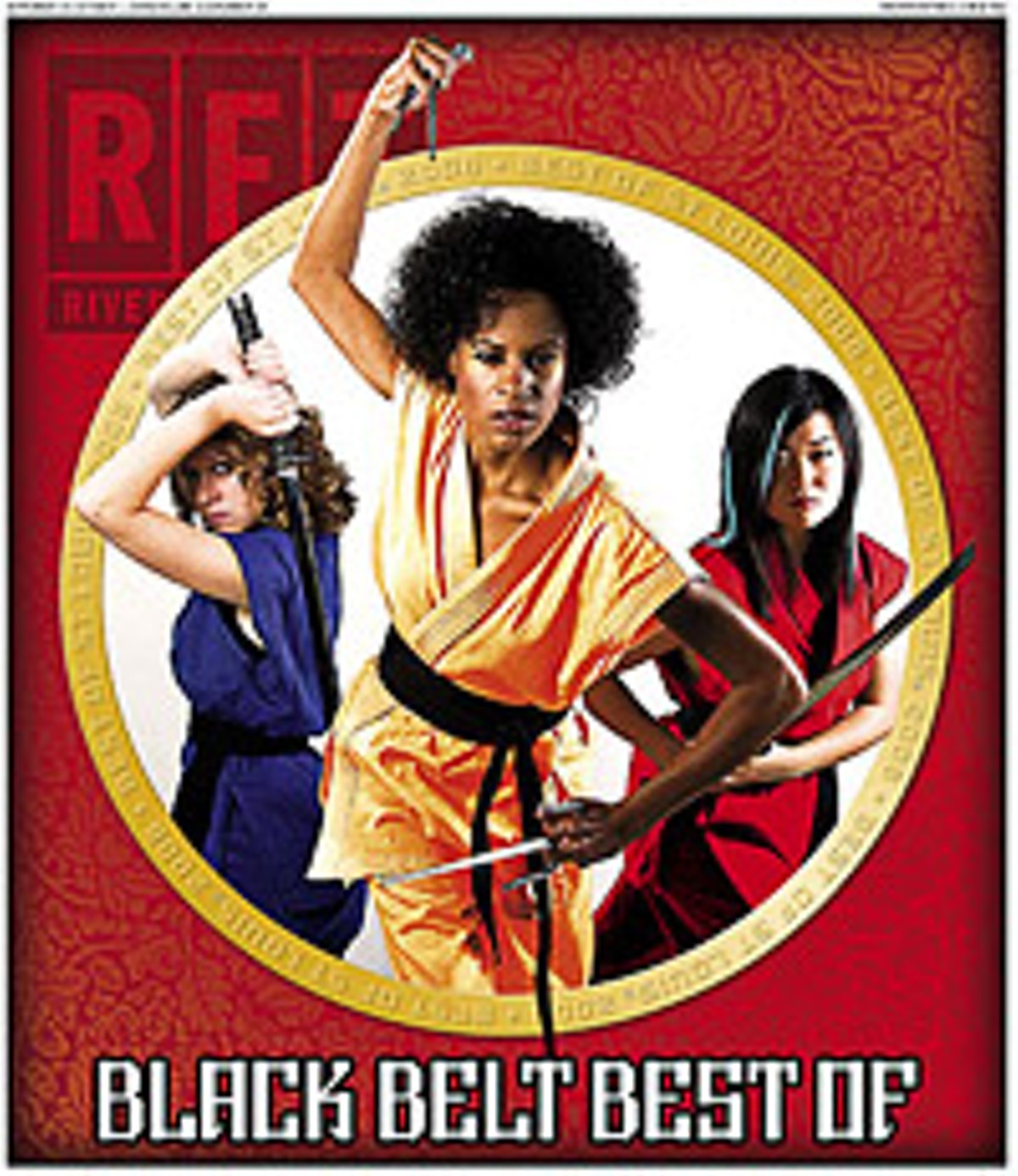Perhaps the most endearing thing about Kurt Kerns' website New Tune of the Week (www.newtuneoftheweek.com) is his notice to music critics: "Unless you have sold over a million records and have played around a thousand shows...shut your hole." Kerns would know; he's best known as the drummer from Gravity Kills. Kerns, who now toils as an architect, started the site last November as a way to help push the buzz surrounding good, underground music. His site design is clever (pal Jason Sullivan did all the back-end coding): a recently released song is featured every week and streamed right off the site. Kerns personally chooses each song; recently featured artists include Cut Copy, the Raconteurs, Foals, PlayRadioPlay! and Pink Thoughts. He offers no content or further review of the week's featured track — the presence of the song on his site is the thumbs-up. Underneath the player are links to the artist's website and to sites where you can purchase the track you've just heard (or the entire album if you're so inclined). Kerns has a slick musical aesthetic and the prerequisite for inclusion isn't based upon how obscure the tune is, only how good.
So maybe there's not a lot of competition in this category. (OK, not any.) But that's not to diminish the many delights of the Washington University Performing Arts Department's spunky production of She Stoops to Conquer. Even if we added Restoration comedy into the mix, then threw in all Kabuki mime plays, She Stoops to Conquer, or The Mistakes of a Night would still be the hands-down, fan-flapping, décolletage-flirting winner. Under the smiling direction of Jeffery Matthews, Oliver Goldsmith's good-natured romp started funny and kept getting funnier as the evening progressed. We say it a lot, but it cannot be overstated: University productions are frequently the best bargains in town. Not only are the tickets cheap (sometimes even free), but often the performances — as they were here — are so accomplished that to describe them as being by students is to unfairly pigeonhole their professionalism.
Mel Brooks' The Producers was a quantum leap from the Muny's usual family-friendly "been there, done that" repertoire. But this paean to crassness was a terrific season opener, thanks in great measure to Lewis J. Stadlen's gloriously misanthropic performance as the incorrigible Max Bialystock. Although Stadlen had already played this eminently corruptible character hundreds of times on Broadway and on the road (including at the Fox), he reconceived it for Forest Park. He also encouraged the Muny to hire a supporting cast of solid actors who already knew the show. And he requested — and received — an extra week of rehearsal in New York prior to coming to town. The result was a reconfigured production, tailor-made for St. Louis, that sparkled with finesse and polish. This, Lew, is for caring so much.
You're a Good Man, Charlie Brown is usually about innocuous smiles and chuckles. It preaches the gospel of forgiveness, because it reminds us that we all have more than our share of shortcomings. But the production earlier this year at Saint Louis University was also about attitude. As Snoopy, Katie McGee was so supercharged with breezy, cocky attitude, she made us all want to go out and adopt a dog. (Preferably her.) And it wasn't just in the big musical numbers like "Suppertime" that she sparkled. Even when standing still on the stage, McGee could fearlessly flirt with the audience simply by staring them down and then batting her eyebrows. She was shamelessly coy and brazenly sensual. If anyone ever earned the appellation "man's best friend," it was this Snoopy.
It's not hard to single out Nancy Lewis as an artist of boldness and daring. But how to single out one of her performances during this past year above the others? Lewis veritably slithered through her withering turn as the tyrannical Violet Venable in Stray Dog's Suddenly Last Summer, and she was sweetly endearing as a toothless old theater crony in the Orange Girls' Playhouse Creatures. But her compassionate portrayal of an artist in decline in Orange Girls' The Road to Mecca was more than mere performance; it was an affirmation of life. An artist in decline? Not Lewis. The ever-growing body of her work (let's not forget her indelible creations in the likes of Women's Minyan, Separate Tables and Enchanted April) — and the intelligence she manifests in the roles she chooses to play — reveal this artist as a unique combination of both grounded and otherworldly.
Say what you will about Metro's budget shortfalls, failed lawsuits and scattershot train and bus service. When it comes to clever commercial spots, the transit agency's "Decongestant M" campaign hits like a bullet train. It's quick. It's timely. And — most important of all — it leaves us wanting to hop aboard. Created by local advertising firm Schupp Co. (www.schuppco.com), the commercials mimic those ubiquitous drug ads that have become the bane of television viewers the world over. Our favorite spot in the series begins with the image of a commuter caught in gridlock caused by Highway 40 construction. As the man takes his hands from the steering wheel to rub his temples, a narrator begins: "When clogging and congestion are at their worst, it's time for Decongestant M. Decongestant M contains the active ingredient MetroLink and MetroBus in a time-release formula that provides rush-hour relief in minutes. Take it once in the morning and once at night to relieve all your symptoms of highway clog." Even better is the disclaimer that's read at blazing speed at the end of the commercial. "Side effects may include less traffic, reduced stress. Should not be taken by those who enjoy sitting in traffic." Metro, funny? Who'da thunk?
Can't sleep. What's on the radio? A deep voice. "From the heartland of America and the Gateway to the West...." Ah, tonight George Noory's broadcasting Coast to Coast AM (www.coasttocoastam.com) from his "cave" in St. Louis (as he was back in April when the earthquake struck — CNN talked to him about it). Who will be his guest — a respected scientist or an "expert" on things paranormal? His topic? Distant viewing. Time travel. Climate change. UFOs. Poltergeists. And Jim White thought things went bump in the night. Athletes on steroids, red-light cameras — those are topics for daytime jabber. We insomniacs demand something more cerebral and night after night turn to our own Joe Buck of the Bizarre. Noory was hosting The Nighthawk on KTRS when he caught the attention of Coast to Coast's producers, and when that show's legendary host Art Bell retired (for real) in '03, George was tapped to be his permanent weeknight replacement, reaching millions of listeners through 500-plus affiliates. He's in town tonight, but even when he airs his show from LA, "his beloved St. Louis" — as one frequent guest refers to it — comes up almost nightly. As the third hour of this gabfest yields to the fourth, the real fun starts as the phone lines open to the listeners. One caller with a fake Irish brogue, Russell from Kentucky, is obviously yanking George's chain. He claims a new synthetic blood is going to allow vampires to come out of the closet. Russell is a vampire, of course, having been genetically combined with a cat (he's got X-rays to prove it). Ever the gracious host, George plays along, continuing the conversation for the next eleven minutes, concluding, "This is one of the greatest calls I've ever had — amazing! Next, from Columbia, Missouri...." Whether a skeptic or a believer, the insomniac listening to Coast to Coast AM faces the nightly dilemma: Turn off the radio and try to get a little sleep or keep listening and stumble through the workday a sleep-deprived zombie. Again.
You may have heard that the crowded local sports-talk arena recently expanded to the FM dial, but the most venerable such show in town and its host, Kevin Wheeler, remain the one-stop station for a complete digest of sports news and chatter: Sports Open Line on KMOX. Weeknights from 6 till 8 p.m., Wheeler plies the mic with humor, smarts and a gregarious nature that invites — and often provokes — caller commentary. He's an ex-jock (University of Miami baseball), but he never comes across as arrogant. It's perhaps telling — and refreshing — in this era of inter-media multitasking that radio is Wheeler's main gig.
Any talk about our town's tameness when it comes to art and art galleries comes to a quick conclusion with three trips down the tongue each ending in "Y": Tighty Whitey Party. Derided by some as a glorified toga party, regaled by others as our town's answer to American Apparel's heroin chic, last June's Tighty Whitey Party at White Flag Projects was a bash for the ages, and the crowning event of the young gallery's second season. Of course, an underwear party does not a gallery make. That takes vision, which, for White Flag, comes in the form of gallery director Matthew Strauss. From its inaugural show, guest-curated by Vice magazine photo editor Tim Barber, to a group show featuring the works of video artists Jill Magid and Marco Boggio Sella, White Flag consistently mounts some of the most challenging exhibitions in town. But best of all, unlike so many galleries in town, White Flag has a dress code that goes something like this: No Pants? No Shirt? No Problem.
Galleries are sort of like plant species: Some are perennial and blossom anew each season, others are annuals that blossom briefly before fading away. The Ellen Curlee Gallery, we now know, belonged to the latter class. But oh, what a bloom it was! Concentrating on modern fine-art photography, the tiny space on Washington Avenue downtown became known for mounting intellectually rigorous shows that often presented several artists — both homegrown and from outside the region — tackling a single issue or idea from radically different points of view. The effect was often heady, and the gallery garnered its share of critical acclaim. But acclaim doesn't pay the bills, and last May, after a three-year run, the gallery's eponymous owner called it quits. But it turns out Curlee herself is something of a perennial: This fall she'll open a new, less formal project space just down the street.
If you run a contemporary art museum, you're bound to run into trouble sooner or later. On the one hand, you are running a museum, meaning you have to present formal shows of museum-caliber work. On the other hand, you're running a museum of contemporary art, meaning you want to bring your museumgoing public the freshest, most interesting art around. And therein lies the rub: A lot of the most interesting current themes in contemporary art may not be quite ready for museum prime time. So what's a contemporary art museum to do? Do you risk ossifying your galleries with the art of last century, or do you throw your lot in with the scruffy young turks? Well, if you're steering the Contemporary Art Museum St. Louis, you cook up a nimble little series like the Front Room. Conceived as a smaller, experimental space that stands in contrast to the museum's more formal galleries, the Front Room is intended to reflect subtler currents in the contemporary art world. Its shows last anywhere from a few days to a few weeks, meaning curators can move quickly to capture mini-movements in the art world. Best of all, the series gives critical exposure to younger artists from out of town that we wouldn't otherwise get the chance to see.









